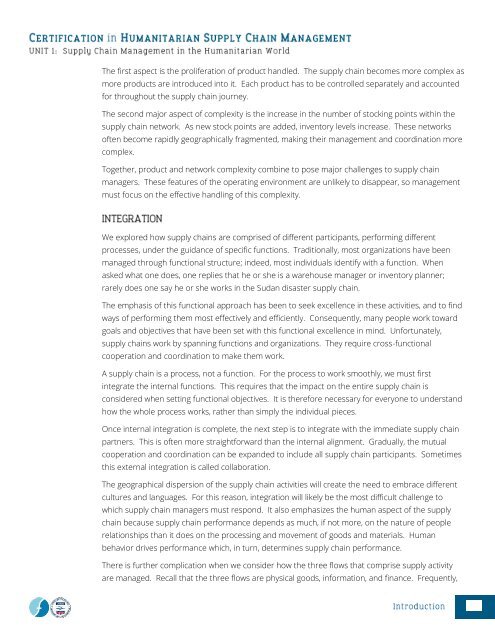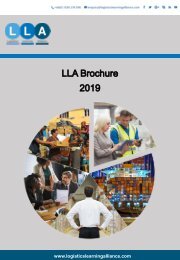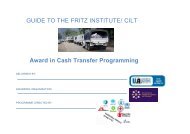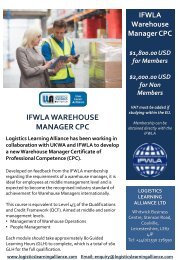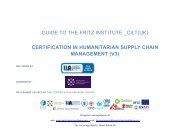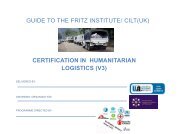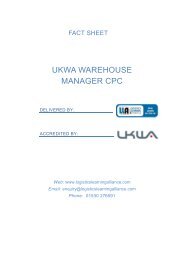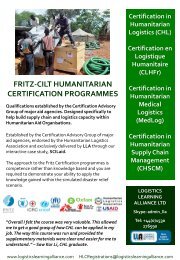CHSCM 3.0 - Unit 1 - SCM in the Humanitarian World
Learning Materials for Unit 1 of the Certification in Humanitarian Supply Chain Management (CHSCM).
Learning Materials for Unit 1 of the Certification in Humanitarian Supply Chain Management (CHSCM).
Create successful ePaper yourself
Turn your PDF publications into a flip-book with our unique Google optimized e-Paper software.
The first aspect is <strong>the</strong> proliferation of product handled. The supply cha<strong>in</strong> becomes more complex as<br />
more products are <strong>in</strong>troduced <strong>in</strong>to it. Each product has to be controlled separately and accounted<br />
for throughout <strong>the</strong> supply cha<strong>in</strong> journey.<br />
The second major aspect of complexity is <strong>the</strong> <strong>in</strong>crease <strong>in</strong> <strong>the</strong> number of stock<strong>in</strong>g po<strong>in</strong>ts with<strong>in</strong> <strong>the</strong><br />
supply cha<strong>in</strong> network. As new stock po<strong>in</strong>ts are added, <strong>in</strong>ventory levels <strong>in</strong>crease. These networks<br />
often become rapidly geographically fragmented, mak<strong>in</strong>g <strong>the</strong>ir management and coord<strong>in</strong>ation more<br />
complex.<br />
Toge<strong>the</strong>r, product and network complexity comb<strong>in</strong>e to pose major challenges to supply cha<strong>in</strong><br />
managers. These features of <strong>the</strong> operat<strong>in</strong>g environment are unlikely to disappear, so management<br />
must focus on <strong>the</strong> effective handl<strong>in</strong>g of this complexity.<br />
We explored how supply cha<strong>in</strong>s are comprised of different participants, perform<strong>in</strong>g different<br />
processes, under <strong>the</strong> guidance of specific functions. Traditionally, most organizations have been<br />
managed through functional structure; <strong>in</strong>deed, most <strong>in</strong>dividuals identify with a function. When<br />
asked what one does, one replies that he or she is a warehouse manager or <strong>in</strong>ventory planner;<br />
rarely does one say he or she works <strong>in</strong> <strong>the</strong> Sudan disaster supply cha<strong>in</strong>.<br />
The emphasis of this functional approach has been to seek excellence <strong>in</strong> <strong>the</strong>se activities, and to f<strong>in</strong>d<br />
ways of perform<strong>in</strong>g <strong>the</strong>m most effectively and efficiently. Consequently, many people work toward<br />
goals and objectives that have been set with this functional excellence <strong>in</strong> m<strong>in</strong>d. Unfortunately,<br />
supply cha<strong>in</strong>s work by spann<strong>in</strong>g functions and organizations. They require cross-functional<br />
cooperation and coord<strong>in</strong>ation to make <strong>the</strong>m work.<br />
A supply cha<strong>in</strong> is a process, not a function. For <strong>the</strong> process to work smoothly, we must first<br />
<strong>in</strong>tegrate <strong>the</strong> <strong>in</strong>ternal functions. This requires that <strong>the</strong> impact on <strong>the</strong> entire supply cha<strong>in</strong> is<br />
considered when sett<strong>in</strong>g functional objectives. It is <strong>the</strong>refore necessary for everyone to understand<br />
how <strong>the</strong> whole process works, ra<strong>the</strong>r than simply <strong>the</strong> <strong>in</strong>dividual pieces.<br />
Once <strong>in</strong>ternal <strong>in</strong>tegration is complete, <strong>the</strong> next step is to <strong>in</strong>tegrate with <strong>the</strong> immediate supply cha<strong>in</strong><br />
partners. This is often more straightforward than <strong>the</strong> <strong>in</strong>ternal alignment. Gradually, <strong>the</strong> mutual<br />
cooperation and coord<strong>in</strong>ation can be expanded to <strong>in</strong>clude all supply cha<strong>in</strong> participants. Sometimes<br />
this external <strong>in</strong>tegration is called collaboration.<br />
The geographical dispersion of <strong>the</strong> supply cha<strong>in</strong> activities will create <strong>the</strong> need to embrace different<br />
cultures and languages. For this reason, <strong>in</strong>tegration will likely be <strong>the</strong> most difficult challenge to<br />
which supply cha<strong>in</strong> managers must respond. It also emphasizes <strong>the</strong> human aspect of <strong>the</strong> supply<br />
cha<strong>in</strong> because supply cha<strong>in</strong> performance depends as much, if not more, on <strong>the</strong> nature of people<br />
relationships than it does on <strong>the</strong> process<strong>in</strong>g and movement of goods and materials. Human<br />
behavior drives performance which, <strong>in</strong> turn, determ<strong>in</strong>es supply cha<strong>in</strong> performance.<br />
There is fur<strong>the</strong>r complication when we consider how <strong>the</strong> three flows that comprise supply activity<br />
are managed. Recall that <strong>the</strong> three flows are physical goods, <strong>in</strong>formation, and f<strong>in</strong>ance. Frequently,


